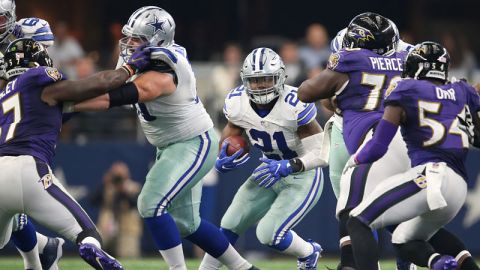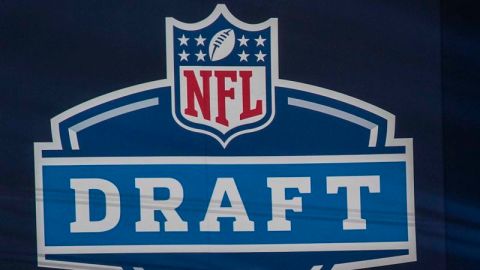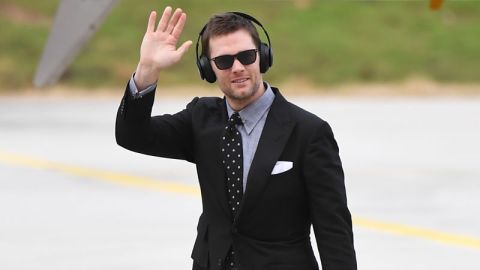6 p.m.: We’ve reached the conclusion of the first day of the MIT Sloan Sports Analytics Conference. We’ll be back Saturday for day two. Be sure to check NESN.com starting at 9 a.m. to see what topics are covered in the country’s biggest meeting sports data analysts.
5:55 p.m.: When asked about over-saturation of sports on television, Walsh points to increased audience sizes and competition from other outlets as proof that fans are actually underserved.
5:45 p.m.: The common challenge that teams in the NBA and Major League Baseball share is how to make teams profitable, Postolos says. Broad revenue sharing is one way leagues are facing this test.
5:40 p.m.: Walsh says that a lot of research will on concussions will come out in the next 12-24 months. He’s sure decision makers will take notice and act on it.
5:30 p.m.: Media is the biggest international opportunity at the moment, de Picciotto says. The next is taking brands globally (through sports). Finally, the movement of talent across borders gives players and fans a chance to see athletes from around the world.
He also thinks gambling has the potential to generate vast amounts of revenue, but it could kill sports as well.
On the question of performance-enhancing drugs, he says essentially need to keep up with societal values.
5:20 p.m.: Walsh asks how to use analytics to value sports properties — especially in increments of time.
PepsiCo has a proprietary model, according to Storms. “Nobody knows our business better than we do,” she says. The company uses a multi-stage process to evaluate the impact of any potential sponsorship or endorsement.
She concludes that there’s no way to measure the exact amount of product that sports partnerships move, but PespiCo is closer than it has ever been to doing so.
5:15 p.m.: Carter says leagues partner with media and sponsors to try and “surround the fan.” She adds that the old model of signage at a stadium no longer works.
5 p.m.: Walsh says we need innovative thinking about the playing of the game and the experience of the consumer.
He points to the fact that players are bigger, faster and stronger than they were decades ago, yet the size of the playing surfaces (specifically in the NFL and NBA) remain the same. “Why not make fields bigger to provide more excitement for fans,” he asks.
4:50 p.m.: The business of sports is our final panel of the day. Industry leaders will talk about the money side of this multi-trillion dollar industry.
Kraft Sports Group vice president Jessica Gelman will moderate the panel. She will be joined by Soccer United Marketing president Kathy Carter, Octagon president Phil de Picciotto, Houston Astros president George Postolos, PepsiCo vice president of global sports marketing Jennifer Storms, and ESPN executive vice president John Walsh.
4:45 p.m.: Schatz says the most overrated players are the ones whose athletic ability doesn’t translate into football success.
He points to D’Angelo Hall who is fast and has good hands but is poor in coverage.
He says Tony Romo is underrated because he is consistently one of the six or seven best quarterbacks in the league and one of the best in the fourth quarter … “as long as the game is not on national television.”
4:40 p.m.: The 49ers use analytics to better understand the tendencies of coaches — how they manage the clock and when they call time outs.
4:35 p.m.: Pioli says mutual respect is lacking in football when asked how to convince an NFL head coach to listen to an analyst who has never stepped on the field.
He says a coach must have an open mind, but it’s important how analysts present, deliver and communicate their information.
4:30 p.m.: Kremer asks how to quantify injuries and off-field problems. What value do you attach to those events?
No two injuries are the same, but Shatz argues that, en masse, players are better at recovering from injuries in today’s game than they were in the past.
As for the character question, Pioli approaches it on a case-by-case basis, saying there’s no real way to measure something like that.
Pioli discusses the new player assessment tool being used at the NFL combine. He wants to know as much about a player’s mental makeup — specifically his levels of work ethic and level of selflessness (or selfishness).
4:25 p.m.: Demoff says the middle class is shrinking because teams are better at scouting and developing young players. Teams are now paying a premium for players they call “difference makers.”
4:20 p.m.: Demoff says the salary caps affect the schemes teams use. They “ultimately look for undervalued players and get as many of them as you can.”
He said more teams started playing 3-4 defenses a few years ago because nose tackles were undervalued. Now the best nose tackles command $12 million salaries, so teams are reverting to the 4-3 because the market allows them to get more bang for their buck with tackles to fit that system.
4:15 p.m.: Marathe calls the Patriots the “kings of replenishing.”
In the age of the salary cap, it’s impossible to keep a team together over the long term. “If every player took a 15-percent discount on their market rate, we still wouldn’t be able to keep them all,” he says.
He adds that the Patriots have been incredible at churning players yet remaining successful.
Pioli says that the Pats’ practice of stockpiling draft picks increases their chancing of landing good players. “Every pick is a gamble,” he said before adding that taking more gambles increases the chances of landing good players.
4:05 p.m.: Pioli says it’s tough to come up with a measurement to predict a player’s chance of success.
“Football is such an interdependent game. The success of a play has so many variables and depends on 11 indiviudals.”
Marathe expands on it, saying that trades don’t often work out because a player can succeed in one system, but look totally out-of-place in another.
3:55 p.m.: Pioli is no fan of the combine because there’s a difference between “pure speed” and “playing speed.”
He finds values in measurements. He says Tom Brady is such an accurate passer because he’s got huge hands.
Marathe talks about “hidden value” of 40-yard dash times, citing the case of Jerry Rice. He says Rice had an average overall 40 time, but his speed between 20-40 yards (what insiders call “the flying 20”) was one of the highest ever.
He said it translated into separation speed on the field. Rice was rarely, if ever, caught from behind.
3:50 p.m.: Demoff and Marathe say their teams are looking to hire analysts. The Rams are still working out how to deeper integrate analytics into their organization, while the 49ers have used one on the salary cap side for over a decade and are now using them on the football side.
Pioli says analytics have played a role in the game for ages. “Gut” decisions are based on prior experience and analysis, he says.
We’re just calling it something else now.
3:40 p.m.: Are you ready for some football?
The National Football League is undergoing an analytics revolution of its own. The Football Analytics panel will discuss how NFL coaches and teams are using data to evaluate players, map out strategy and make in-game decisions.
Andrea Kremer will moderate the panel. She will be joined by St. Louis Rams executive vice president of football operations Kevin Demoff, former Patriots and Kansas City Chiefs general manager Scott Pioli, San Francisco 49ers chief operating officer Paraag Marathe and Football Outsiders founder Aaron Schatz.
2:40 p.m.: Robin van Persie does his exploring in the half second before the ball comes his way. It’s how he always seems to be one step ahead of defenders (despite not being particularly fast or quick) when he gets the ball in the final third of the field.
2:30 p.m.: Jordet says Frank Lampard and Steven Gerrard have the highest frequency of “visual exploratory behavior,” meaning the two stars look around and gauge their surroundings before receiving the ball.
He says the midfield players who complete the highest number of forward passes are the ones who do the most exploring. In other words, they’re reading the game and playing it at the same time.
He bases the research on Sky Sports’ player cameras.
2:25 p.m.: We’re going from one extreme to the other. Baseball and statistics are inseparable, but soccer has been slow to adopt statistical analysis.
Geir Jordet, director of psychology at the Norweigan Centre for Football (soccer) Excellence is presenting some new research on “The Hidden Foundation of Field Vision in English Premier League Soccer Players.”
He explores the concept of field vision. How can some players make the right pass every time they get the ball? We’re about to find out.
1:50 p.m.: The panel discusses how difficult it is to predict how a young player will perform in the big leagues. There’s no exact science or measurement device that will predict which players will overperform or underperform at the top level.
1:40 p.m.: Posnanski says there’s a real divide in the way journalists cover baseball. He thinks younger writers — especially on the internet — are more versed in the “new language” of analytics, while mainstream media still focuses on wins, losses, errors and other 100-year-old statistics.
He thinks baseball coverage is currently changing and will continue to change with the times.
1:30 p.m.: Zaidi says analytics are changing the way the game is played and how managers manage.
McCracken adds that managers tend to want to avoid risk. If he plays a star player and the player doesn’t deliver, “it’s the player’s fault.” If the manager plays an untested rookie and the youngster fails, “it’s the manager’s fault.”
1:20 p.m.: When asked what the newest developments in baseball analytics, Keri says that teams are increasingly privatizing and keeping data in house. McCracken thinks this will slow the growth of the baseball analysis.
He goes on to say that video analysis is the next frontier in the field.
Zaidi says baseball analysis is too tied to outcomes rather than skills themselves. The A’s are trying to move in the direction of skill-based analysis rather than outcomes (which are the results of those skills).
1:15 p.m.: Zaidi drew chuckles from crowd when he said Billy Beane calls him “The Emotional Stat Guy.”
He adds that baseball decisions are very complex and there are a lot of disagreements, but Beane has to make the final call at the end of the day.
1:10 p.m.: Posnanski says that baseball provides new things to measure and quantify almost every day. Where some sports might see diminishing returns from the avalanche of data, he thinks that won’t be the case in baseball.
McCracken thinks the data can be dangerous. Some take a new stat and run with it without “completely understanding” the data that they’re seeing.
12:55 p.m.: We’re getting set for one of the most anticipated panels of the first day — on baseball analytics.
Sabermetrics are gaining influence among baseball’s decision makers. Grantland staff writer Jonah Keri, NBC Sports writer Joe Posnanski, statistical analyst Voros McCracken and Oakland Athletics director of baseball operations Farhan Zaidi will discuss how teams are using analytics to gain a competitive advantage. ESPN’s Lindsey Czarniak will moderate.
11:20 a.m.: Polian and MacMullan talk about the Manti Te’o hoax and its effect on the player.
The former Colts general manager thinks the hoax won’t have a negative impact on his career over the long term.
“The hoax that he was a victim of is a story, and it’s a gigantic story — people can’t get enough of it,” Polian says. “Does it affect Manti Te’o the football player? I would submit to you absolutely not.”
MacMullan agrees with that assessment, but she thinks the hoax has had negative effects on his preparation for the NFL combine.
“He was probably not capable of preparing the way he would have liked to have because of all the outside noise and all the outside things that have happened to him.
“I don’t know this for a fact, but perhaps he may have under-performed at the combine because anyone that went through what he went through, regardless of how much you think he was involved or not involved, it had to have been devastating. There had to have been a lot of sleepless nights. There had to have been a lot of days he probably didn’t eat, and I’m sure a lot of days he didn’t work out the way he wanted to.”
11 a.m.: Pagliuca talks about the perspective owners and managers need. The best ones see things over an 82-game season “like a movie.”
Polian talks about a parallel universe we live in. Fans and media expect perfection over the course of an 82, 16 or even 162-game season. Professionals know that perfection is “almost never achievable,” and coaches teach against mistakes that are part of the business.
10:50 a.m.: Burke and Van Gundy have spoken about the most difficult aspect of their jobs as coaches and general managers.
They agree that the hardest part is cutting players — guys that “bleed for you” as Burke says. The human element, specifically the bonds that form in the locker room are tough to break.
10:45 a.m.: Burke likes hard coaches. They’re his favorite ones. But the former Toronto Maple Leafs president and general manager says “the harder the coach is, the shorter his shelf life.”
10:40 a.m.: Pagliuca tells us that one of the best decisions the Celtics have made (since he’s been one of the team’s owners) was not firing Danny Ainge and Doc Rivers in the 2006-07 season.
10:20 a.m.: Van Gundy is discussing the Dwight Howard saga in Orlando. He says Howard asked for him to be fired and was causing a problem in the Magic locker room.
He wished Magic management would come out with a statement — either back him with a new contract or fire him — and end the distraction. They didn’t.
Polian says Jim Finks, Red Aurebach and Branch Rickey are the three greatest executives in history. He adds that coaches are useful for a maximum of 10 years. The ones that are able to “recognize and prepare them [players] are the ones that last longest.”
10 a.m.: “It’s Not You, It’s Me: Break-Ups in Sports” is our first panel of the day. Moderator Jackie MacMullan will lead a discussion about high-profile trades, public disputes over hirings and firings and other media spectacles.
John Buccigross, Bill Polian, Steve Pagliuca, Brian Burke and Stan Van Gundy will explore how high-profile changes affect on-field performances.
9 a.m. ET: In the span of seven years, the MIT Sloan Sports Analytics Conference has become the place to be.
Sports insiders, executives and leading researchers from around the country and beyond descend on Boston for two days to discuss role of analytics in the sports industry with each other and thousands of students.
The Boston Convention and Exhibition Center is the site of this year’s conference. Nate Silver, Brian Burke, Adam Silver, Mark Cuban, Jonathan Kraft and Michael Wilbon are just a few of the panelists that will be on hand to give and receive insight into how sports are being changed by “big data.”
We are on hand for the 2013 conference, looking to see where the next breakthrough in sports analytics will come from. Join us here on March 1 for the latest on sports data analysis.
Have a question for Marcus Kwesi O’Mard? Send it to him via Twitter at @mkomard, his Facebook page or send it here. He will pick a few questions to answer every week for his mailbag.



